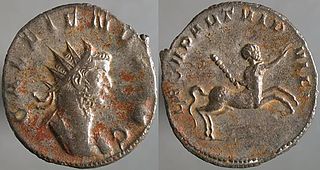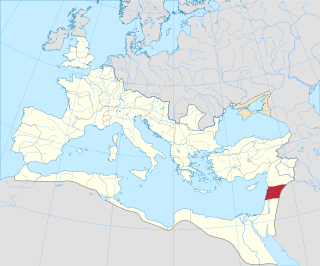
Septimia Zenobia was a third-century queen of the Palmyrene Empire in Syria. Many legends surround her ancestry; she was probably not a commoner and she married the ruler of the city, Odaenathus. Her husband became king in 260, elevating Palmyra to supreme power in the Near East by defeating the Sasanian Empire of Persia and stabilizing the Roman East. After Odaenathus' assassination, Zenobia became the regent of her son Vaballathus and held de facto power throughout his reign.

The Roman provinces were the administrative regions of Ancient Rome outside Roman Italy that were controlled by the Romans under the Roman Republic and later the Roman Empire. Each province was ruled by a Roman appointed as governor.

Legio II Parthica was a legion of the Imperial Roman army founded in AD 197 by the emperor Septimius Severus, for his campaign against the Parthian Empire, hence the cognomenParthica. The legion was still active in the beginning of the 5th century. The legion's symbol was a centaur.

Praeses is a Latin word meaning "placed before" or "at the head". In antiquity, notably under the Roman Dominate, it was used to refer to Roman governors; it continues to see some use for various modern positions.

Septimius Odaenathus was the founder king (Mlk) of the Palmyrene Kingdom who ruled from Palmyra, Syria. He elevated the status of his kingdom from a regional center subordinate to Rome into a formidable state in the Near East. Odaenathus was born into an aristocratic Palmyrene family that had received Roman citizenship in the 190s under the Severan dynasty. He was the son of Hairan, the descendant of Nasor. The circumstances surrounding his rise are ambiguous; he became the lord (ras) of the city, a position created for him, as early as the 240s and by 258, he was styled a consularis, indicating a high status in the Roman Empire.

Vicarius is a Latin word, meaning substitute or deputy. It is the root of the English word "vicar".
Comes, often translated as count, was a Roman title or office.

Septimius Vaballathus was emperor of the Palmyrene Empire centred at Palmyra in the region of Syria. He came to power as a child under his regent mother Zenobia, who led a revolt against the Roman Empire and formed the independent Palmyrene Empire.

A Roman governor was an official either elected or appointed to be the chief administrator of Roman law throughout one or more of the many provinces constituting the Roman Empire.

Legio V Macedonica was a Roman legion. It was probably originally levied in 43 BC by consul Gaius Vibius Pansa Caetronianus and Gaius Julius Caesar Octavianus. It was based in the Balkan provinces of Macedonia, Moesia and Dacia. In the Notitia Dignitatum records from beginning of the fifth century, the legion was still stationed in Dacia, with detachments stationed in the east and Egypt.
Consularis is a Latin adjective indicating something pertaining to the position or rank of consul. In Ancient Rome it was also used as a noun to designate those senators who had held the office of consul or attained consular rank as a special honour. In Late Antiquity, the title became also a gubernatorial rank for provincial governors.

The Palmyrene Empire was a short-lived breakaway state from the Roman Empire resulting from the Crisis of the Third Century. Named after its capital city, Palmyra, it encompassed the Roman provinces of Syria Palaestina, Arabia Petraea, and Egypt, as well as large parts of Asia Minor.

Arcadia or Arcadia Aegypti was a Late Roman province in northern Egypt. It was named for one of the reigning Augusti of the Roman Empire, Arcadius of the Theodosian dynasty when it was created in the late 4th century. Its capital was Oxyrhynchus and its territory encompassed the Arsinoite nome and the "Heptanomia" region.

In the Late Roman Empire, usually dated 284 AD to 641 AD, the regional governance district known as the Roman or civil diocese was made up of a grouping of provinces each headed by a Vicarius, who were the representatives of praetorian prefects. There were initially twelve dioceses, rising to fourteen by the end of the 4th century.
Augustamnica (Latin) or Augoustamnike (Greek) was a Roman province of Egypt created during the 4th century and was part of the Diocese of Oriens first and then of the Diocese of Egypt, until the Muslim conquest of Egypt in the 640s.

The Diocese of Egypt was a diocese of the later Roman Empire, incorporating the provinces of Egypt and Cyrenaica. Its capital was at Alexandria, and its governor had the unique title of praefectus augustalis instead of the ordinary vicarius. The diocese was initially part of the Diocese of the East, but in ca. 380, it became a separate entity, which lasted until its territories were overrun by the Muslim conquest of Egypt in the 640s.

The quaestor sacri palatii was the senior legal authority in the late Roman Empire and early Byzantium, responsible for drafting laws. In the later Byzantine Empire, the office of the quaestor was altered and it became a senior judicial official for the imperial capital, Constantinople. The post survived until the 14th century, albeit only as an honorary title.

Phoenice was a province of the Roman Empire, encompassing the historical region of Phoenicia. It was officially created in 194 AD and after c. 394, Phoenice Syria was divided into Phoenice proper or Phoenice Paralia, and Phoenice Libanensis, a division that persisted until the region was conquered by the Muslim Arabs in the 630s.

Phoenice Libanensis, was a province of the Roman Empire, covering the Anti-Lebanon Mountains and the territories to the east, all the way to Palmyra. It was officially created c. 394, when the Roman province of Phoenice was divided into Phoenice proper or Phoenice Paralia, and Phoenice Libanensis, a division that persisted until the region was conquered by the Muslim Arabs in the 630s.














